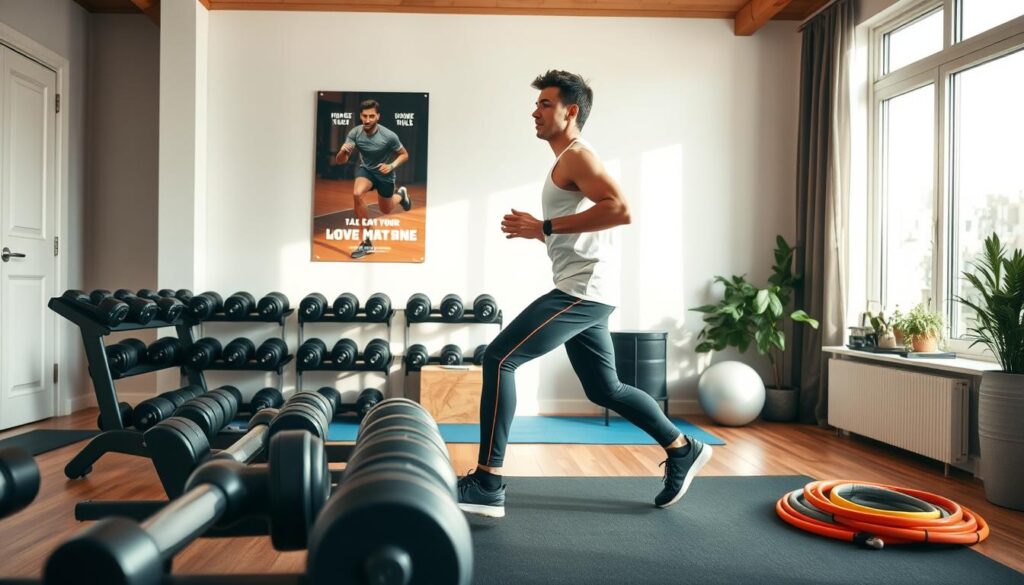In today’s world, it’s hard to find time for exercise, especially if you’re always busy. But elevator cardio workouts offer a creative way to fit in cardio during your day. With many people working desk jobs, finding easy ways to stay active is key. You can use small spaces like elevators for quick exercise. This article will show you how short exercises can improve your fitness, even when you’re busy. These tips will help you add effective workouts to your day without changing your schedule much.
Understanding the Importance of Cardio Workouts
Cardio workouts are key for better health and heart strength. These exercises make your heart work harder, get your blood moving, and help your lungs work better. The American Heart Association suggests doing aerobic exercise for 30 minutes, five days a week, and lifting weights twice a week. This routine boosts both your body and mind.
Regular cardio helps you control your weight. It burns calories and speeds up your metabolism, which is great for people with busy lives. Doing cardio often also makes you feel happier. It fights off sadness, worry, and stress by releasing feel-good chemicals in your brain. A healthy heart rate during exercise can make you emotionally stronger.
Adding cardio to your daily routine is easy. You can choose stairs over elevators or ride a bike to work. Places like gyms offer classes that help you keep up with your cardio. Knowing how important cardio is can change your life. It’s not just about staying fit; it’s about living better and longer.
Benefits of Mini Workouts for Busy Individuals
In today’s fast-paced world, many people find it hard to fit exercise into their busy lives. Mini workouts offer a great solution for keeping fit despite a tight schedule. Lasting just 10 minutes or less, these short bursts of activity boost energy and mental clarity. They help fight off tiredness and make you more productive.
Studies show that adding short workouts to your day can improve your heart health, strength, and endurance. High-intensity interval training (HIIT), even in short spans, can greatly enhance fitness. Hence, short workouts make it possible to get a full exercise routine without feeling stressed. They’re easy to do during breaks or while running daily errands, making working out more accessible.
Mini workouts are versatile; you can do squats, push-ups, or planks in little breaks. If you stack up at least 10 minutes each day, you’ll get similar benefits to longer, continuous exercise sessions. This flexibility helps you stay consistent with your fitness goals. By regularly doing short workouts, you can prevent burnout, improve your focus, and lift your mood. So, mini workouts are a practical fitness solution for those strapped for time.
How to Fit Cardio into Your Day
Trying to add cardio into your daily life can be hard, especially when you’re always busy. Managing your time well is key. You can find small moments throughout the day for cardio exercises. Even quick jogging or jumping jacks during short breaks can help make exercise easier to fit in.
Begin your day with a fast walk or some jump rope. It wakes you up and starts your day off right. During work breaks, don’t just eat. Try walking around or stretching too. Mixing up your activities can make your day better and keep you healthy.
Getting your family involved in exercise can be fun, too. Take walks together after dinner or play sports like basketball on weekends. Even simple things, like parking farther away or taking stairs, add to your fitness without taking much time.
Doing structured exercises in short bursts can be very effective. For example:
- Jumping Jacks: Do them for one minute, take a thirty-second break, and start again.
- Stairway Workout: Run or walk fast up stairs, then go down slowly. Do it more than once if you like.
- Chair Squats: Stand up from a chair, lower yourself back down without sitting, and stand up again. Do this ten times.
These exercises help you meet the goal of 150 minutes of moderate cardio exercise each week. Even just an hour of cardio a week can lower your risk of dying early. By planning your day right, you can make time for fitness every day.
What Are Cardiovascular Workouts in the Elevator
Cardio workouts in the elevator offer a cool way to fit exercise into busy days. This approach uses the small space of an elevator for health benefits. It’s perfect for improving heart health without needing a gym.
Leveraging Limited Spaces for Effective Cardio
Elevators are great spots for quick cardio exercises during a hectic day. Here are some easy activities to do in an elevator:
- Leg Curls: Stand tall, put weight on one leg, and bend the other. Hold for 10 seconds, then switch legs.
- Glute Squeeze: Stand up straight and tighten your glute muscles for 3 seconds. Relax, then do it again.
- Shoulder Shrugs: Lift your shoulders up towards your ears, hold for 5 seconds, then let go.
- Praying Stretch: Put your palms together in front, keep elbows touching, move them apart while lowering hands to your waist. Hold this for 10-30 seconds.
- Calf Raises: Stand straight, go up on your toes, squeeze your calves for a few seconds, then come back down.
- Isometric Shoulder Exercise: Face an elevator wall, push a raised fist against it, hold, then switch fists.
Creative Exercises to Perform in Elevators
Working out in the elevator can be a fun way to keep fit. Take stair climbing, for instance, it boosts heart health big time. It can lower the chance of dying from any cause by 24%. Using the stairs every day works out lots of muscles and helps control weight.
Quick and Effective Elevator Workouts
Elevator workouts are a great way to stay fit on the go. They use the small space of an elevator for quick cardio exercises. These activities save time and are very effective. Below you’ll find easy workouts for any busy day.
Examples of Quick Workouts
- High Knees: Perform this exercise for 30 seconds to elevate your heart rate.
- Calf Raises: Stand on your tiptoes to strengthen your calves.
- Shadow Boxing: Engage in punches for a fun and dynamic cardio burst.
- Goblet Squat: Use a water bottle for resistance while squatting.
- Dumbbell Skier Swing: If space allows, incorporate a light dumbbell for a full-body workout.
- Buttock Pinches: Stand and engage your glutes for a quick toning exercise.
- Abdominal Flexes: Strengthen your core even while standing.
- Stretching Exercises: Include hamstring and shoulder stretches to regain flexibility.
Timing and Frequency Recommendations
For these elevator exercises, use short bursts of activity. Try doing each exercise for 30 seconds with small breaks. Doing these workouts 3-5 times daily meets your cardio needs well. Each session takes about 5 minutes, perfect for any schedule. Regular workouts like these improve stamina and heart health during your daily commute.
Tips to Stay Consistent with Cardio Routines
It can be hard to stick with workout plans, especially when you’re busy. Creating a routine for cardio needs a good plan and motivation. Here are some tips to help keep you on track:
- Set Achievable Goals: Start with goals that you can reach. This helps build confidence and keeps you moving forward.
- Use Triggers: Pick specific times or signs to remind you it’s time to work out. Making habits around these cues can help you stay consistent.
- Make It Enjoyable: Pick exercises that you like doing. Loving your workouts helps keep you motivated for longer.
- Incorporate Movement Daily: Find ways to add activity into your day. Small steps, like using stairs or walking on breaks, make a big difference.
Start your cardio with a 5–10 minute warm-up to get your heart rate up. Then, work on slowly upping how hard and long you work out. Use the talk test or how you feel to keep track, and adjust when you need to.

Don’t forget to stretch after working out to keep your muscles flexible. Try adding a minute more of cardio each time or doing a bit more each week. This helps you keep getting better, even with a busy schedule. These tips can make a big difference in sticking with your exercise plan.
Enhancing Your Elevator Cardio Experience
Integrating technology and finding inner drive can greatly boost elevator cardio workouts. With modern tools, you can make your workouts better and stay focused, especially when you’re always on the go. Fitness tech not only tracks your progress but also makes your goals seem within reach.
Using Technology for Tracking Progress
Fitness apps and wearable trackers are key in keeping an eye on cardio workouts. They check heart rates, count calories burned, and give fitness insights. Tracking your progress gives you feedback that motivates you to keep improving your exercise routine.
By setting clear goals, like climbing six to ten flights of stairs daily, you have a concrete aim. This aim is linked to greater health gains, such as reducing heart disease risk by 39%.
Finding Motivation in Your Daily Commute
Thinking of exercise as part of your daily schedule can change how you see its importance. ‘Active commuting’ elevates your cardio and boosts overall health. Opting for stairs over elevators is an easy way to fit in exercise during your day.
Regular stair climbing is a solid workout combo of aerobics and muscle building, improving leg strength and heart health. Research indicates that stair climbing can decrease the risk of heart issues by 20%. By adopting these habits, your daily commute can become a source of exercise motivation.
Safety Precautions for Elevator Workouts
Working out in an elevator can be a smart way to fit exercise into a tight schedule. Making safety a top priority during your workouts helps you stay safe. Here are some important tips for elevator workouts.
- Avoid direct hand contact with elevator buttons by using gloves or alternative tools to minimize exposure to germs.
- Practice social distancing by maintaining at least one meter from others in the elevator.
- Encourage regular cleaning and disinfection of elevator surfaces, including buttons, handrails, and walls.
- Use technology, such as elevator call apps, to minimize physical contact with shared surfaces.
- Avoid crowded elevators to reduce the risk of germ transmission.
By following these safety steps, you make your elevator workouts safer. Always talk to a health care pro before starting any new exercise plan. This includes doing workouts in small spaces. Making smart choices keeps your workouts both safe and effective.
Conclusion
Integrating elevator cardio into daily life is smart for those with busy schedules. Taking stairs boosts heart health, strengthens muscles, and helps control weight. It’s a way to stay fit and tackle a busy schedule.
Stair climbing improves heart function and burns calories. It also lifts your mood and lowers stress. Making these small changes can improve your health greatly. Choosing stairs over elevators improves both body and mind.
The final word on elevator cardio is clear. By choosing stairs, we make a healthy choice for ourselves. And we help create a better future.



